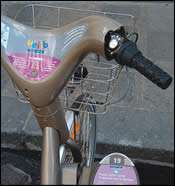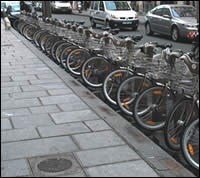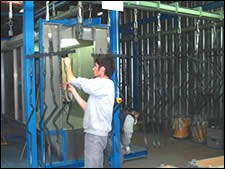French Revolution
An urban bike Movement is sweeping Paris, and French custom coater Solyap is riding the wave
#pollutioncontrol
Solyap is a powder coater located in the Rhone Alps region near Lyon, France. The company launched its first powder coating operation in 2004 with the idea that it could provide fast, flexible service and high quality finishing of new products built and used locally. From the beginning, Solyap managers looked for work that reflected an urban setting with an eye on the twin pressures of overseas competition and clean environmental technology. Powder coating was an obvious choice for environmentally conscious clients, but the company also wanted to look for business that would fit the needs of the day and meet various French and European standards while remaining competitive.
With flexible processing and smart marketing, Solyap has grown from a business of around €1.5 million ($2.2 million) in 2005 to €2.5 million ($3.7 million) in 2007. The company currently does about 20% of its business with European automobile OEMs including Mercedes Benz, BMW, Renault and Peugeot. Solyap also processes castings for various companies and runs a substantial amount of work for transportation companies such as Bombardier and electronic components for customers such as Philips.
Featured Content
“Bicycle Freedom”
A product that fell perfectly into Solyap’s business plan is rental bicycles. Vélib (shortened from the French “vélo liberté”—in English, “bicycle freedom”) is a public bike rental program launched in Lyon in 2005. Following initial success in Lyon, the program was transplanted to Paris in a big way in 2007.
Initially, the Paris program launched with 10,000 bicycles and 750 hire points with 15 or more bikes/spaces in each station. These numbers have since grown to more than 20,000 bicycles available at 1,450 automated rental stations.
The self-service “bicycle transit system” allows Parisians and visitors to pick up and drop off bicycles at any station throughout the city. A 30-min use is free, enabling users to hop from one station to the next, run errands or commute to work via bike. Riders can also select a one-day card for €1, a weekly card for €5 or an annual card for €29. Each Vélib parking station is equipped with meters that let users purchase one- and seven-day passes and to pay any additional charges once the bike is dropped off. Meters also provide information on other station locations.
The concept behind the city-run system is to provide simple and quick access to non-polluting city transportation and reduce the number of cars used in the city center. French Mayors Gerard Collomb in Lyon and Bertrand Delanoe in Paris have strongly backed the initiative, even ripping up streets in order to add more than 125 miles of new bike paths to city streets.
A longtime green campaigner, Delanoe pledged when he was elected in 2001 to reduce automobile traffic in the city center by 40% by 2020. These initiatives have encouraged bike use in general and provided additional growth in bicycle manufacturing, sales and service.
In addition to providing a cleaner alternative transportation method, the bikes provide revenue for the city and jobs for those who build and service them.
The bikes, custom-designed for durability amd theft-deterrence, are reported to cost around $1,300 each, with a total investment cost (including infrastructure) of about €90 million ($120 million).
Just how did the city pay for this massive undertaking? Urban advertising giant JC Decaux shelled out the initial investment, which paid for both the docking stations and the bikes and will continue to cover bike maintenance.
The cash investment was in exchange for 10 years of exclusive use of 1,628 urban “street furniture” billboards on bus shelters, newsstands, public toilets, and so on. To help offset lost advertising revenues, the city of Paris will received 100% of the Velib user subscription fees.
JC Decaux also designed the bikes, which were built by French bicycle manufacturers Lapierre and Orbita. The chunky gray bikes with baskets mounted on their handlebars will never be mistaken for racing bicycles, but form follows function and these bikes are intended for commuting to work, jaunts to the market and other daily tasks.
In order for the Vélib concept to work, the rental stations and bicycles had to be built in a short time frame and installed quickly so there would be enough hire points to make the system work. The bicycle manufacturing program turned into a high-priority rush. Some parts were built in Hungary and Portugal. Other components came from China, Italy and France, but all of the parts were coated in Europe, providing a great opportunity for Solyap.
The company was in a good position to take on this work, having opened its first powder line just before the bicycle program began in Lyon. The city wanted a finish in keeping with the environment goals of the bicycle program, making powder coating a natural choice.
Solyap had its first powder line, and was able to provide the additional capacity required for fast turnaround times by adding people and opening up additional shifts. This in turn enabled the bicycle manufacturers to get the bikes built quickly and on schedule.
Powder Operations
Line One at Solyap is still used for most of the company’s products, which include automotive tubing, bus seating, arm rests for transportation seating, lamp posts, aluminum cast wheels, fuel tanks and metal furniture in addition to the bike frames, component parts and kiosks used to dispense bicycles at Vélib hire stations.
The line is built to process aluminum, steel, magnesium and galvanized steel components. It can handle parts up to 30 inches high × 18 inches wide × 120 inches long (76 × 46 × 305 cm) at a line speed of 3–4 fpm (1–1.2 m/min).
The washer is a five-stage in-line spray system that includes a cleaner/coater, city water rinse, reverse osmosis (RO) water rinse, non-chrome seal rinse and final rinse stages. This pretreatment process is robust enough for Solyap’s indoor products. Components destined for outdoor use are processed in a batch wash system or receive a primer coat of powder epoxy under the topcoat to improve outdoor corrosion and UV resistance. Cast parts are degassed in the dry off oven before powder application by raising the parts to a temperature to a point higher than the ultimate cure temperature.
The system currently uses a single manual booth with two operators, but Solyap managers plan to add another booth with a reciprocator and automatic guns. The same booth is used for application of primers and topcoats. Parts that require a primer coat are cycled two times, one cycle for each coating.
Expansion plans include an infrared oven installed with the new booth to provide two-coat capability in a single pass by using one booth for primer and the other for top coat application. Parts will be sprayed with primer in the existing booth, then pass through the IR oven to partially cure the powder. From the IR oven, components will move through the new topcoat booth to receive the top coat and then move into the convection cure oven for final cure of both coats.
Solyap managers expect this new arrangement to provide a significant increase in daily production time and allow them to take in more work. The company currently runs Line One three shifts and Line Two on two shifts, so they are anxious to complete the additions and continue to grow.
The batch wash process consists of a series of immersion tanks used to apply different pretreatments for steel, galvanized steel, magnesium and aluminum components. Parts are loaded in baskets or on racks and transported through the system by a programmable overhead hoist. Different metals can be processed in different tanks, enabling pretreatment for optimum performance based on the intended application. Table 1 shows the batch pretreatment sequences used for steel and aluminum alloy workpieces.
The setup lets Solyap provide exceptional pretreatment on both types of metal in the same system. The pretreatment system can handle parts up to 11.5 ft (3.5 m) long. Managers say the non-chrome conversion coating is giving them excellent adhesion and corrosion performance on aluminum and magnesium.
Pretreated components are removed from the baskets and hung onto conveyors for transport through one of the two lines. Built to handle additional capacity as the bike program expanded into Paris in 2007, Line Two features two manual powder booths that can handle parts up to 32 inches wide × 48 inches high × 60 inches long (80 × 122 × 152 cm).
| Table 1 – Batch Pretreatment sequence for steel and aluminum workpieces | |
| Steel | Aluminum |
| Alkaline cleaner | Cleaner |
| Rinse | Rinse |
| Rinse | Rinse |
| Iron phosphate | De-oxidize |
| Rinse | Rinse |
| Rinse | Rinse |
| Rinse | Rinse |
| Non-chrome seal rinse | Non-chrome conversion coating |
Parts can be pretreated in the batch system and then coated on either line, or they can be primed on Line One and then top-coated on Line Two. This arrangement provides flexibility for production and different processes for the variety of substrates and performance requirements. With all the different pretreatment options, Solyap can offer 1,000+ hr of salt-spray resistance on aluminum parts and 650 hr on magnesium and steel components.
Another addition to the company’s pretreatment options is a small grit blast system. Parts are hung on a carousel rack and run through the blast cabinet to remove weld contamination, die marks and laser edge before they are cleaned and coated. Removal of these inorganic soils provides significantly enhanced corrosion resistance and adhesion on some products without adding a lot of additional wash stages or requiring strong acidic cleaning chemistries.
Regulatory Compliance
Speaking of chemicals, environmental and worker safety regulations are a critical part of the business at Solyap and throughout Europe. One of the new issues facing finishers in the EU is REACH—Registration, Evaluation, Authorization and Restriction of Chemical substances. In effect since June 2007, REACH is aimed at protecting human health and the environment through better and earlier identification of the intrinsic properties of chemical substances. The regulation requires industrial users to manage the risks from chemicals and provide safety information on the substances. It also calls for progressive substitution of the most dangerous chemicals as suitable alternatives are identified.
First proposed in 2001, REACH will eliminate grandfathering of commonly used chemicals and continue to require testing of new chemicals. This forces even small businesses like Solyap to carefully evaluate every chemical they use. Because these regulations are just now taking hold, their ultimate impact is still unknown.
Another critical regulatory issue at Solyap is compliance with the Restriction of Hazardous Substances (RoHS) directive. To be RoHS-compliant, Solyap must guarantee that new electrical and electronic equipment they supply doesn’t contain more than agreed-upon levels of lead, cadmium, mercury, hexavalent chromium, polybrominated biphenyl and polybrominated diphenyl ether flame retardants. They are able to comply by using non-chrome rinses and conversion coatings.
RELATED CONTENT
-
Preventing Solvent Pop
Preventing solvent pop on an industrial paint line...
-
Painting Over Powder Coating
How safely can they apply their wet paint over our powder coated parts?
-
A Current Affair: Examining the "No Amperage" Phenomenon
If you are performing a coating process that requires the use of a rectifier, you may have experienced the "no amperage" problem. Here's a look at the phenomenon and some solutions…























